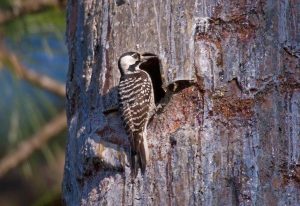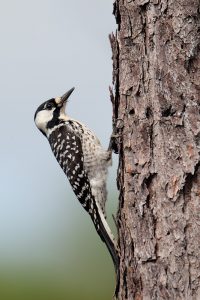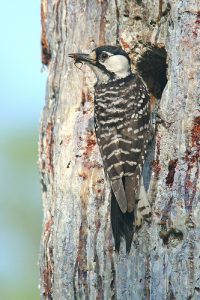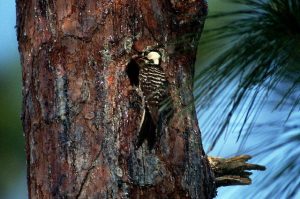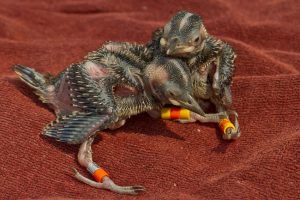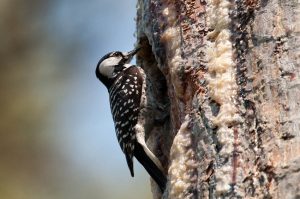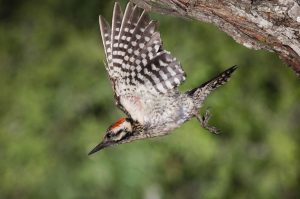Red-Cockaded Woodpecker
Red-cockaded woodpeckers are birds found exclusively in pine forests, especially ones with an abundance of longleaf pines.
Scientific Classification
| Kingdom | Animalia |
| Phylum | Chordata |
| Class | Aves |
| Order | Piciformes |
| Family | Picidae |
| Genus | Leuconotopicus |
| Scientific Name | Leuconotopicus borealis |
Quick Information
| Also Known As | Carpintero cara blanco (Spanish), Pic a face blanche (French) |
| Description | Size: 7.1-9.1 in (18-23 cm) Weight: 1.4-2 oz (40-56 g) Wingspan: 13-16 in (34-41 cm) Bill length: 0.75-0.91 in (1.9-2.3 cm) Color: Belly and breast are gray with black spots on the edges, sides of the face have large patchy white feathers, black bill with gray feathers at its base |
| Distribution | Southeast of the United States |
| Habitat | Found in mature pine forests, they prefer longleaf pines the most |
| Communication | At least 20 distinct calls are used to communicate with each other, for example, ‘churts’, ‘sklits’, ‘kweek’, she–uuu’, and ‘wicka’ are all used for specific purposes |
| Lifespan | Information inadequate, however, one individual was banded in Louisiana in 1984 and died in 1999, thus it lived for at least 16 years |
| Diet | Being insectivores, they primarily eat beetles, ants, larvae; they also eat fruits and seeds |
| Adaptations |
|
| Predators | Rat snakes and corn snakes prey on this bird |
| IUCN Conservation Status | Near Threatened |
Behavior
Red-cockaded woodpeckers are diurnal, being active throughout the day, involved in foraging for foods, self-maintenance, and flying. They are a non-migratory species. They live in family groupings consisting of up to 5 individuals. All members of this group may help the breeding pair in incubating the eggs and raising the young once they hatch.
Mating & Reproduction
These birds are monogamous. The courting process sometimes can last up to a year. The breeding season is usually between April and June. A clutch consisting of up to 5 eggs is laid, at a rate of one egg per day. The incubation period lasts for around 10 to 12 days.
Life-cycle
Hatchlings are born with a weight of around 0.12 oz (3.3 g). Feathers appear after 4 days of hatching. Their eyes open after 10 days and eventually they fledge after around 26 days of birth. They are entirely independent within 4-6 months. They reach sexual maturity at 8 months of age.
Interesting Facts
- This bird is one of the most studied woodpeckers in the world.
- Male red-cockaded woodpeckers have a red streak on either side of their black head; this is called a cockade, earning them the name.
- Another accepted scientific name for this bird is Picoides borealis.
- There is an estimated population of around 12,500 individuals at present.
References:
- https://www.nwf.org/Educational-Resources/Wildlife-Guide/Birds/Red-Cockaded-Woodpecker
- https://www.allaboutbirds.org/guide/Red-cockaded_Woodpecker/lifehistory
- https://www.fws.gov/species/red-cockaded-woodpecker-picoides-borealis
- https://www.biologicaldiversity.org/campaigns/esa_works/profile_pages/RedcockadedWoodpecker.html
- http://animaldiversity.org/accounts/Picoides_borealis/
Published on June 28th 2017 by Sudipto Chakrabarti under Coniferous Forest Animals.
Article was last reviewed on 5th December 2024.


